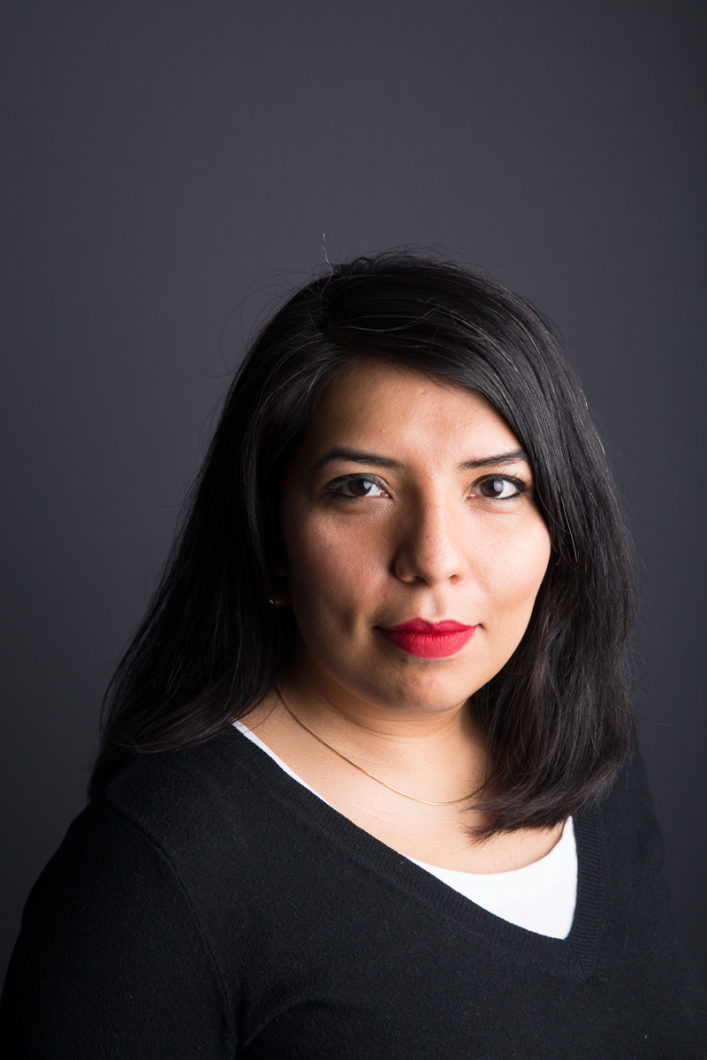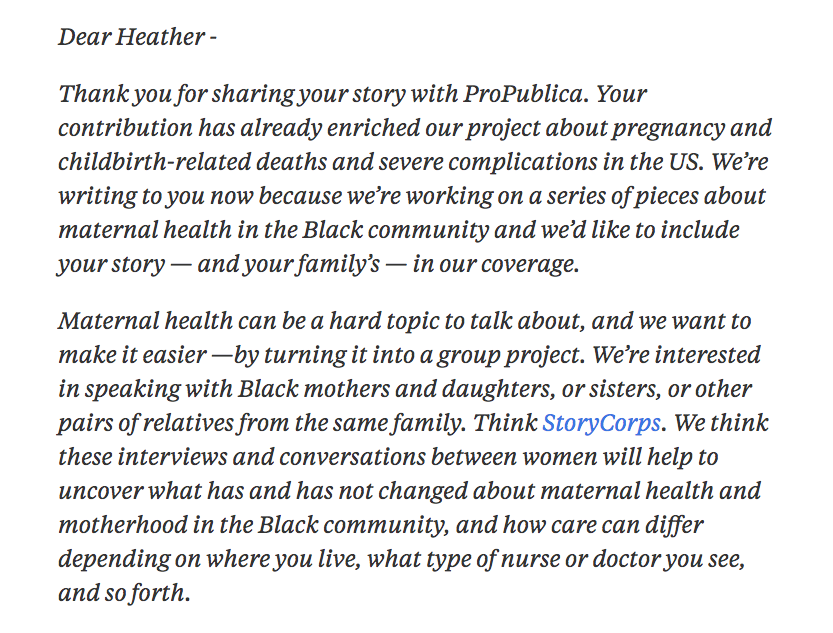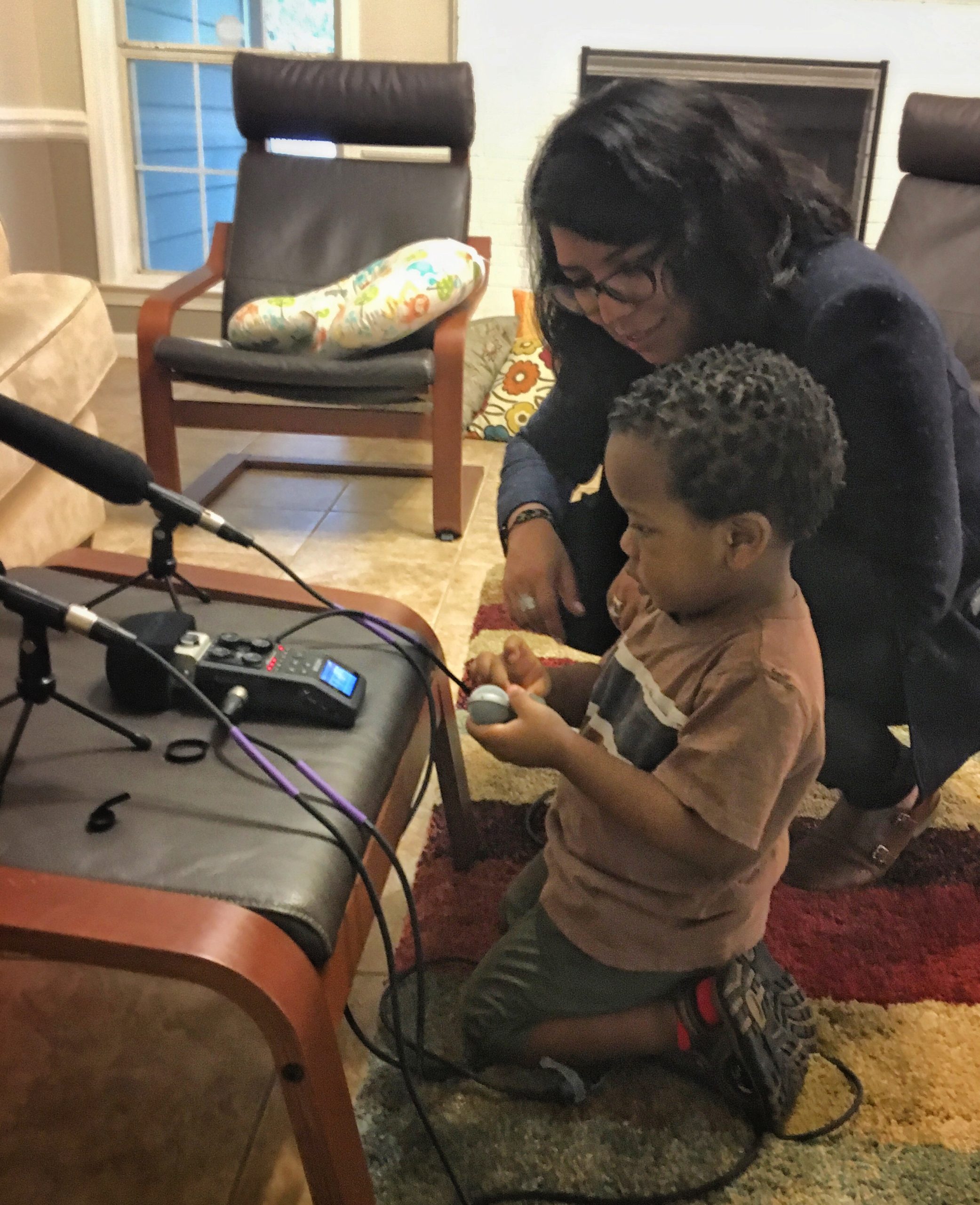
Every year, about 700 to 900 American women die from causes related to pregnancy and childbirth. And for every death, dozens more suffer life-threatening complications. It’s a shockingly high toll of maternal harm for a developed nation with wealth and resources. In fact, the maternal mortality rate in the U.S. is double that in Canada and Australia. It’s even higher than the rates in Saudi Arabia and Libya. Yet the problem has managed to go fairly unnoticed.
ProPublica and NPR aimed to change that with their Lost Mothers series last year. They decided to use engagement reporting, inviting the public to collaborate in their investigations through social media, online forms, phone calls, and in-person forums. The method allowed the organizations to find nearly 5,000 families affected by maternal deaths and near-misses.
There was one problem though, says Adriana Gallardo, engagement reporter at ProPublica. Out of a sample of 5,000 responses, there were only 200 about the experiences of black women—despite the fact that black mothers die at three to four times the rate of white mothers.
Clearly the call ProPublica and NPR had put out for stories was not reaching a diverse audience, Gallardo says. So she decided to try something unique, something ProPublica had never done before.
Gallardo sent out a message to the 200 people who had responded to the initial callout with stories about black women, inviting them to discuss their experiences with pregnancy or childbirth—either firsthand or as a loved one of someone affected—with their mothers, daughters, and friends. And she asked them to record those conversations. It was a model of journalism Gallardo had picked up in her previous experience at StoryCorps, a nonprofit that records conversations between friends, family, and others as a way of telling stories and preserving history.
Gallardo’s message eventually led to a journey into women’s private living spaces, an intimate look at the generational impact of maternal harm, and an elevation of black women’s voices in the national conversation. The finished story was published December 8, 2017 under the headline: “Black Women Disproportionately Suffer Complications of Pregnancy and Childbirth. Let’s Talk About It.”
Here, Gallardo talks to Aneri Pattani about how this story came together.
The first callout for the Lost Mothers series, asking readers if they knew someone who died or nearly died in pregnancy or childbirth, went out in February 2017. How soon did you notice you weren’t hearing back from as many black women?
The numbers were clear immediately. We heard back from so many women that first weekend we launched the callout. At first we were just overwhelmed to receive so many responses. But very quickly it became clear that while we had filled one gap, now there was another. In the beginning there were maybe only a dozen cases about black mothers in a batch of 2,000. I think this says a lot about the audience that we had shared the callout with. This went out with ProPublica and NPR, and those aren’t publications that reach a wide range of people.
You’ve said before that the idea to record black women in conversation with one another came from your previous work at StoryCorps. What made you think that model would work well for this topic?
I’ve believed in the StoryCorps model for a while just from having been on the road, recording hundreds of conversations. But also, my team at ProPublica believes that engagement should be used for difficult conversations. So this seemed like an opportunity to use a model I knew worked well for difficult conversations in a way that could apply to investigative work.
Also, the whole Lost Mothers series is laced with things ProPublica hadn’t done before. For example, the advice piece sourced from women who nearly died about what they wish they had known ahead of time—that was a nontraditional piece that came from engagement. So by December, when we were packaging this racial disparities piece, we weren’t afraid to take a different approach to gathering content that was straight from the group of women who nearly died. (This interview has been edited for length and clarity.)
How did you find women to participate in this?
We started to think about this in September of 2017, about seven months after the initial callout. So we already had people who had replied to that original message about knowing women who died or nearly died in childbirth. A big benefit of that is you can stay in touch with this group of people, continue to ask more questions, build a relationship and hopefully bring them with you through the reporting process.
So by September I’d already sent a few messages to that group [of all the women]. Typically we would get back dozens of replies. We just got fewer replies from African American women when we asked the entire group a question.
So this time I wrote a message and sent it only to African American women in the group. About two dozen responded, maybe more. This was the first time I’d heard from so many African American women.

Did you have any concerns when you sent out that message, asking black women to record their conversations about maternal mortality?
Yes, I thought they would think it’s maybe disrespectful to ask them to interview each other because I’m basically divorcing myself from leading this interview process. I also thought they might think we were trivializing their experience by pitching something like this.
But that wasn’t the case. They were excited to talk to each other. I heard back immediately from dozens of women in this group of 200 black mothers on our list. They knew who they’d want to have this conversation with, too—moms or aunties or daughters. I don’t know if they were familiar with the StoryCorps concept, but they went along with me.
More than two dozen women responded, but the final piece only includes 10. How did you pick those 10?
I talked to almost all of the women who got back to us saying they were interested in doing this. Some of the narrowing came from logistics—who could record within the time frame we had. But I was also trying to see if they were good talkers and if they were able to talk about what happened to them in a clear-headed way. It takes people different times to be able to deal with these kinds of conversations. Candice Williams’s scare was six years ago and this was the first time that she was able to talk about it. But Heather Dobbs’s complication had been in February and we were talking in October.
Then I also filtered for the pairs that would allow us to cover different types of complications. We wanted to organize the piece that way so that it connected back to the overall series, where we had talked about many different complications in different ways. Instead of just lumping all the women into a group who almost died from maternal complications, this format allowed us to say this is her name, this is what complication she suffered, and this is a person who was there with her and cares a lot about her. It was a way to help readers navigate what could have just been a very long piece about 10 people.

How did you prepare for the recording sessions?
Like any other piece of journalism, I did background calls with both members of each pair. I asked about the type of scare one or both of them had experienced, the type of care they had received, and if they were together during the experience. I learned about who they were, their dynamic, what they had experienced, and what would be appropriate to include in their set of questions. I spent a lot of time on those questions.
My interest in speaking with them was really just to get background on who they were, what they experienced, and what would be appropriate to include in their set of questions. So we couldn’t just give them a generic list to ask their mom or whoever they were going to sit across from. That’s where I think the questions felt so comfortable, because I had already understood a little about their relationship, and what type of scare, and what type of care they had received.
There were about a dozen questions for each partner. I wanted to give them plenty of options so that if they weren’t comfortable with whatever I put on there, they could move to another one that made sense for them. Some of the questions were to get the conversation started, so maybe, “What is your first memory of me?” or “Why was it important to you to be a parent?” That way the conversations were larger than the complication and the very traumatic parts. It was also about them as women and becoming mothers and having children and raising them.
I sent each pair the questions the night before. I didn’t want them to prep complicated answers, but I did want them to see them. This is a very triggering topic, so I didn’t want it to be a complete surprise.
What were the recording sessions like? Since it was mainly a conversation between the two participants, what was your role?
I recorded two of the pairs in person and the other three on the phone. One of the in-person ones was Heather and Avis in Georgia. It was a Saturday morning in their living room. Both of Heather’s kids were there. Her son Cameron ended up helping us with the equipment, and Heather held her baby daughter the entire time. We had to pause a few times so Heather could breastfeed. That was just as real as it gets from having met someone on a form to having them open their house to you.
The second one we did in person was with Shalon’s mom, Wanda. [Shalon died three weeks after giving birth.] That was a totally different one. While the first interview was a survivor with her mom and kids, this one we were in Shalon’s home where her mother is raising Shalon’s daughter. We were very much paying respect to Shalon in her space.
In both cases, my role was to set up the equipment, hand them printouts of questions, and instruct them on how to kick off the conversations. Then I literally stepped back and wouldn’t interrupt unless I needed to. Really for that hour, it was just them in conversation.
When we did it on the phone, it was more difficult because I couldn’t see the people. I was listening on my headphones. I figured out how to respect the silences and awkward pauses. There was a lot said between them that was super personal.
What did you learn as a journalist from just listening rather than leading the conversation?
It was difficult in that I had put all my eggs in the basket of the questions. I had to trust those questions were good enough to give me what I thought would be an interesting piece. But ultimately this process made me more confident that there are many ways to conduct an investigation and interviews. You don’t have to be the one with all the questions. I had told the women that if they wanted to ask anything that wasn’t on the list, that was game. And sometimes they did ask better follow-up questions than I could have thought of. It really further nails down the idea that engagement is best used for difficult situations, for difficult reporting.
You recorded hour-long conversations with each pair, but the final piece includes just short snippets of audio. How did you pick them?
The tape was really great, so it wasn’t difficult to find moments. What was important to me was staying true to the dynamic each pair had. I didn’t want to pull something just because it was particularly traumatic or particularly predictable. I wanted to share clips that showed this is what Wanda and Asha, for example, actually sounded like. It was important for me to have the audience hear the questions as well, so it was actually authentic to what we had recorded. We didn’t do a lot of editing or moving pieces of the conversation around. What you hear is probably how they said it naturally. They were also wonderful talkers so it wasn’t hard.
It can be intimidating to use engagement for sensitive topics. What did you learn about best practices from this process?
You can call it engagement, you can call it anything else. But it’s really about identifying the gaps in your reporting. What are the things I’m not going to be able to get to in the traditional form? We knew women affected by this issue were out there. They are the source. They can tell us more than anyone. So as intimidating as all of this is, it’s really taking steps to fill those gaps. It’s a little more digestible if you break it down by reporting gaps—like data or human stories—and search for people who can help you tackle them.
And you need to have symbiotic relationships with people who become your sources. It’s the ultimate challenge of not being extractive. They give you all this info and share something super personal, so we as reporters need to be open to their feedback and ideas. Sometimes we would send them messages that weren’t with questions but just updating them, saying this is a thing you guys helped us make, or this is what we’re thinking of doing next if you have any thoughts on the topic. It’s a lot of really listening and being flexible to being guided by the process. That’s engagement.
What advice do you have for reporters who’d like to use this storytelling approach for other stories?
Something I caution people about: I don’t think engagement works for every type of story. For example, you can’t do this on daily pieces. You need a long runway for engagement. You need time.
One way to be more efficient though is to be smart with the questions you ask. Don’t put out really wide questions that you know you’re not going to really use. From the beginning, our callout was very specific about finding women who died or nearly died in childbirth. Not finding difficult pregnancies. Not finding traumatic experiences at the hospital. We were filtering for only the stories we knew we were going to write about. That’s one way to be respectful of people’s time and attention.
Finally, the best thing I can say is to strive for a balance between being hyper-prepared with questions and then just trusting that the people who are sitting in front of you can do this. Whatever they share is going to be useful either to them or to you. It’s really about being open to accepting that conversations are also a way to learn. And it doesn’t have to be your conversation.

Aneri Pattani is a TON fellow sponsored by the Burroughs Wellcome Fund. She is an assistant producer on the health team at WNYC. Originally from Connecticut, she graduated from Northeastern University in Boston in May 2017. That summer, she worked as a James Reston reporting fellow on the health/science desk at The New York Times, and traveled to Liberia on a reporting trip with columnist Nicholas Kristof. She has previously written for The Boston Globe, The Texas Tribune, CNBC and The Hartford Courant. Outside of reporting, Pattani loves to travel, cook, and practice Indian classical dance. Follow her on Twitter @aneripattani.


